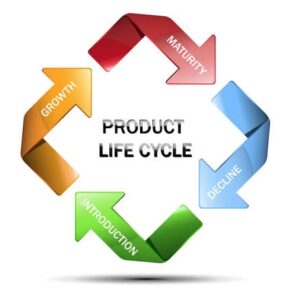Stages of the product life cycle with importance of managing and examples
What is the life cycle of a product?
In this article we will provide you the Stages of the product life cycle with importance of managing.
The life cycle of a product is a term used to describe the stages of creation, growth and purchase that any product goes through on its way to and through users. The traditional stages of a product’s life cycle are development, introduction, growth, maturity, and decline.
The life cycle of a product plays an important role in the sales and therefore the profits of a company. That is why it is important to address it before launch. But not only do you have to worry about management and control, the product life cycle also affects marketing.

Why to know the life cycle of a product?
Knowing what phase a product is in allows a more efficient allocation of resources. Therefore, the life cycle of a product must also influence the choice of marketing tools used in each phase of the cycle.
Marketers use the product life cycle to create marketing strategies that reach a wide audience of consumers, to brand and to price the product .
Product managers use the product life cycle to assess development resources, investment, and maintenance for a product or feature.
Enhance your reading: Customer Health Score with making and measurement with 3 keys
Stages of the product life cycle
These are the stages to correctly determine the life cycle of your product:
1-Ideation
The cycle begins with an idea that becomes a concept. Ideation is the process that includes evaluating new product objectives, investigation of market suitability, market demand, competitor analysis , investigation of utility, potential revenue opportunity, and potential costs. .
Many parts of the organization are often involved in this phase, such as marketing, product, engineering, design, and employee engagement . They can damage relationships between teams, weaken trust in company management of the organization.
2-Developing
Development begins once market demand has been assessed and ideation has resulted in a formalized plan for a new product. The stage includes the final designs, written requirements, and acceptance criteria.
Engineers, product managers, customer experience designers, and quality assurance analysts are often the main contributors in this phase. Marketers are in the strategy phase when the product enters the development phase and they begin planning market positioning and pricing for the introduction phase.
3-Introduction
Introduction begins after development is complete, as soon as a viable product is available for use. In this phase, the market will know the product for the first time.
Many times, marketers take the initiative to bring the new product to market based on the strategy they created during the development phase. The introduction strategy includes the target market segment, the channels and forms of advertising that will be used to introduce the new product, and the messages that will be used when marketing it to consumers.
4-Increase
Growth is the stage when customers adopt the new product. The adoption of the product continues to increase and the benefits as well. Sales teams may even be incentivized to sell the new product to existing and potential customers.
Development teams often continue to make changes and improvements to the product during the growth stage. Teams are monitoring the product to achieve the goals that were set during ideation. The product continues to receive investment in the form of marketing and development efforts.
5-Maturity
Maturity is reached when the adoption of the product no longer grows at an exponential rate and has reached its saturation in the market. Teams may decide to continue investing in the product to remain competitive, or they may leave it unattended while they focus on other product efforts in earlier stages.
Many times in the maturity stage the product receives at least minimal development for maintenance, but marketing efforts have become minimal.
6-Decline
The decline occurs when the market no longer needs the product in the same way that it did during the early stages of the product life cycle. Customers abandon the product and sales are likely to decline.
Many teams decide to stop supporting the product during the relegation phase and either abandon it or decide to withdraw it from the market entirely. This occurs when customer usage drops to a low percentage of the overall customer base.
Some teams may reinvent the product at this stage by adding new features, finding new market segments for the product, or repackaging the product to allow for new marketing efforts.
Whether the product is abandoned or reinvented, letting a product reach the state of decline allows the team to refocus on the product life cycle.
The importance of managing the life cycle of a product
Understanding the product life cycle is critical to both product and marketing teams and the organization as a whole. Stages help teams understand what level of investment a product should receive, which products in the company’s portfolio should receive the most attention and investment, and which products have the most opportunities for growth, revenue, and profit.
Lifecycle management affects many teams in the organization, especially those in sales, marketing, and product development. The Product Lifecycle Framework helps teams make tough decisions about existing products, while helping new ideas grow.
Real examples of product life cycles
THE life cycle of a product can be applied to both products and services and the concept can be applied to any brand you see on the market today. We leave you clear examples of brands and services that you know
1-Example of the life cycle of a food product (Oreo Cookies)

Below we leave you an example of the life cycle of Oreo cookies from a business point of view according to the 4 stages:
Introduction : In 1912, Oreo cookies were first introduced to the American market. At this stage, sales were modest and the company had to invest in advertising and promotion to publicize the product. Consumers had to learn about the features and benefits of Oreo cookies, and the company had to create a distribution network to reach a broader audience.
Growth : In the 1920s, sales of Oreo cookies began to grow rapidly. The company was able to build on the momentum by increasing production and expanding distribution nationwide. During this phase, the company focused on improving product quality and consistency to keep consumers loyal and satisfied. Advertising and promotion continued to attract new customers and maintain public interest.
Maturity : By the 1950s, Oreo cookies had become an iconic and very popular product around the world. During this phase, the company focused on efficient cost management and optimization of production processes. They also focused on brand expansion through new products such as Oreo milk and Oreo cream. Advertising and promotion focused on keeping customers loyal and attracting new consumers through creative marketing campaigns.
Decline : In the 2000s, the company began to notice a decline in sales of Oreo cookies. During this phase, the company focused on innovation and launching new flavors and products to attract new consumers and keep current ones interested. The company also focused on expanding into new markets and diversifying its product portfolio. Additionally, the company has used advertising and promotion to try to revitalize the brand and increase awareness among consumers.
2-Example of a service life cycle (Amazon)

Amazon‘s life cycle can be described using the four stages of the product life cycle in marketing:
- Introduction: In 1995, Amazon was introduced as an online book selling platform. At this stage, Amazon had a narrow focus on its product offering and was focused on building a loyal customer base and establishing its online presence. Amazon also focused on building logistics infrastructure to handle its deliveries efficiently.
- Growth: As Amazon began to expand its product and service offerings, its sales began to grow significantly. The company invested in advertising and marketing to build on the momentum and expand its customer base. Amazon also focused on building strategic alliances and international expansion.
- Maturity : In the maturity stage, Amazon has become one of the largest and most successful companies in the world. The company offers a wide range of products and services, including literature of the 15th century . Some of his features are present in chivalric books, electronics, fashion, among others. Amazon has also developed its own technology, such as the virtual assistant Alexa and Amazon devices such as the Kindle and Echo. At this stage, Amazon has focused its attention on the continuous improvement of its operations processes, offering an excellent customer experience and expanding its presence in the international market.
- Decline: While Amazon is not currently in the decline stage, it is important to note that all companies will eventually face challenges that can lead them to this stage. In the case of Amazon, potential challenges include intense competition, changing consumer preferences, and the evolution of the online marketplace. If Amazon faces a decline, it will need to make important decisions about the company’s future, such as withdrawing some of its products or services, focusing on new opportunities, or innovating its product and service offerings.
In summary, Amazon‘s life cycle demonstrates how a company can evolve from an online book selling platform to a company that offers a wide range of products and services around the world. Amazon ‘s success is due in large part to its quality of life. These patients are limited in their ability to adapt and evolve in an ever-changing market.
3-Clothing brand life cycle example (Nike)

An example of the life cycle of a well-known clothing brand could be Nike, one of the leading brands in the sports clothing market. The four stages of Nike’s life cycle are described below:
- Introduction : In the 1960s, Nike was founded as a sports shoe company. During the early years, Nike focused on the production of running shoes and sponsored famous athletes to promote their products. At this stage, Nike worked hard to build its brand and establish a presence in the market.
- Growth : During the 1970s, Nike began to expand into other markets, such as basketball and tennis, and launch new products, such as sportswear and accessories. At this stage, Nike increased its market presence and share through diversification and launching innovative products.
- Maturity : In the 1980s and 1990s, Nike consolidated its position as a leader in the sportswear market and experienced continued growth. During this stage, Nike focused on maintaining its dominant position in the market and building customer loyalty through innovative advertising campaigns and the introduction of new technologies in its products.
- Decline : In the 2000s, Nike faced competition from other sportswear brands and had to adapt to new market trends, such as demand for eco-friendly and sustainable clothing. At this stage, Nike focused on diversifying its product offering and developing new technologies to maintain its position in the market and attract a new generation of consumers.
In summary, Nike has gone through the four stages of the product life cycle in marketing, from introduction to decline. During each stage, Nike has had to adapt to new market trends and develop innovative strategies to maintain its position in the sportswear market.




